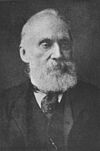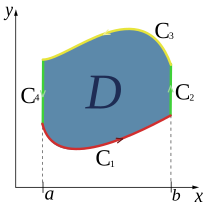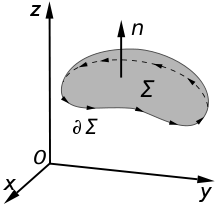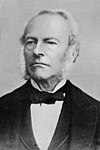This article refers to Stokes's integral theorem. Further laws, rules and theorems established by the physicist and mathematician Sir George Gabriel Stokes under
Stokes' laws .
The set of Stokes or Stokes' integral theorem is one of Sir George Gabriel Stokes named set from the differential geometry . In the general version it is a very fundamental theorem about the integration of differential forms , which extends the main theorem of differential and integral calculus and opens a connection line from differential geometry to algebraic topology . This relationship is described by de Rham's theorem , for which Stokes' theorem is fundamental.
The point is to convert -dimensional volume integrals over the interior into -dimensional edge integrals over the surface of the volume piece . Often only special variants of the general theorem are considered, from which the general principle is more or less clear, but which are important for the respective applications. The two most important special cases, the Gaussian integral theorem and the special Stokes integral theorem (see below) come from vector analysis . In physics and electrical engineering , Stokes 'or Gauss' special theorem allows elegant ways of writing physical relationships, for example in the integrated forms of Maxwell's equations .


Stokes' integral theorem
statement
Let be an oriented n-dimensional compact differentiable manifold with a smooth edge in sections with induced orientation . This is the case for most illustrative examples, such as the full sphere with rim (sphere) or the torus (lifebuoy).


Furthermore, let an alternating differential form of degree be defined on (or in a sufficiently large open environment) , which is assumed to be continuously differentiable .



Then the following statement applies, named after Stokes:

where denotes the Cartan derivative . The right integral can be understood as a surface integral or more generally as an integral over the manifold .


The Cartan derivation is here to a certain extent "dual" to the topological operation , which results in the cross-relation contained in this formula between aspects of analysis and topological-algebraic aspects.


Remarks
Under the very general assumption that applies with -dimensional base forms , for example with





and with the external product , which among other things fulfills the condition of antisymmetry , the external derivation specifically says the following:



The proof of the “main theorem” becomes particularly easy if, as in the adjacent example of a normal area, the integration manifold (named in the drawing ) can be segmented into vertical stripes (in the direction) so that only on the yellow “upper side” and on the The red "underside" of the posts results in non-trivial contributions, because of the orientation (the arrow directions) with opposite signs .


Inference
Be open and be a continuously differentiable form in . Then for every oriented compact frameless -dimensional submanifold the statement applies :







Applications
Stokes' (general) theorem is mainly used in mathematics. He
- contains as special cases for physicists and electrical engineers the Gauss theorem and the special Stokes theorem (see below), and
- Second, it forms a concrete connection between differential geometric and algebraic aspects of topology , in that two different paths and , which start from the same starting point and lead to the same end point, are defined as topologically homologous in a differentiable manifold if the curve integral disappears for certain single-stage differential forms . Corresponding terms of algebraic topology can also be built up with the higher-dimensional Stokes' theorem.




Stokes' integral theorem for chains
Integration via chains
Let be a smooth -Simlex and a smooth, closed differential form on the smooth manifold . Then the integral over is defined by





-
 .
.
It denotes the return transport from regarding . The definition makes sense since it is a smooth submanifold with border and induced orientation of . (Or you simply understand it as a closed subset of the .) In this case , the definition corresponds to the usual curve integral . Is a smooth - chain of the singular complex , then the integral is over defined as













In the event you find the definition and more information in the article cycle (function theory) .

statement
Let be a smooth chain of the singular complex and a smooth differential form on the smooth manifold . Then applies






With which is boundary operator of the singular complex called.

application
This theorem shows a connection between differential geometric and topological properties of a smooth manifold. If one considers the De Rham cohomology and the singular homology of , one obtains through




with a homomorphism . Based on Stokes' theorem, this homomorphism is well-defined and the choice of representative of the homology class is not important . Let and be two representatives of the same singular homology class, then the following applies , because two representatives only differ by one element of the boundary. Hence it follows from Stokes' theorem






The last equality holds because it is an element of De Rham cohomology and therefore holds. If an exact differential form then applies




According to de Rham's central theorem, homomorphism is even an isomorphism .
Underlying topological principle
Behind Stokes' theorem there is a general topological principle which, in its simplest form, states that in the case of “oriented paving of an area” inside, the paths “due to oncoming traffic” cancel each other out in pairs, so that only the edge curve remains.
On the left in the sketch you can see four small, identically oriented “paving stones”. The “inner paths” drawn in the middle are traversed in pairs in opposite directions; their contributions to the line integral therefore cancel each other out, so that only the contribution of the boundary curve remains. It is therefore sufficient to prove the integral theorems only for the smallest possible “paving stones”.
If the paving is sufficiently refined , this is generally almost elementary.
Special cases
Several special cases of Stokes' general theorem are important in classical vector analysis. This of course includes the classic Stokes theorem. It follows from the general theorem with . In addition, the main theorem of differential and integral calculus , Green's theorem and Gaussian integral theorem are special cases of Stokes' general theorem.

Law of differential and integral calculus
Let be an open interval and a continuously differentiable function. Then there is a 1-form (so-called Pfaff's form ), and the general Stokes' integral theorem degenerates to

![f \ colon [a, b] \ to \ R](https://wikimedia.org/api/rest_v1/media/math/render/svg/c5ab61178bf5349838758ffe3d96135406ed0245)


This is the main theorem of differential and integral calculus.
Gaussian integral theorem
For a compact subset of and an n-dimensional vector field , the Gaussian integral theorem is obtained as a further special case.




The -dimensional normal is the unit vector and the integrals are now - or -dimensional, where the size is also written as. One chooses







so the Gaussian integral theorem results from Stokes's.
This theorem can also be used to define the divergence of a vector field , this definition being independent of the coordinates used.
Classic integral theorem from Stokes
The classical Stokes integral theorem is also known as the Kelvin-Stokes theorem, or the law of rotation . It is used by physicists and electrical engineers, especially in connection with Maxwell's equations. It states that an area integral can be converted into a closed curve integral through the tangential component of the vector field via the rotation of a vector field . This is helpful because the curve integral contains the vector field alone and is usually easier to calculate than area integrals, especially if the area under consideration is curved. In addition, the curve integrals are directly affected in many applications - and only secondarily the associated area integrals - for example in Faraday's law of induction . Given specifically , the fact that many different manifolds can be "squeezed" into a single closed boundary manifold leads to the gauge invariance of theories such as Maxwell's .



statement
Let it be an open subset of three-dimensional space and a defined vector field that is once continuously differentiable. This is required so that the expression can be formed. Furthermore, let be a two-dimensional regular surface contained in , which is oriented by a unit normal field (that is, let us define what the “upper side” of the surface is). In addition, the tangent unit vector is the boundary curve. The regular property ensures that the edge is sufficiently smooth.








The edge of is denoted by. In the following, this edge is always identified with a closed curve. With all of these conditions applies



-
 .
.
You also write in the applications
-
 ,
,
with and . Furthermore, the rotation, and (or ) is the scalar product of the two vectors . The shape is the volume shape of the two-dimensional surface and is the length element of the boundary curve.









Remarks
In the event that represents a flat subset , in appropriate coordinates . If not flat, it can be, provided that the two-dimensional surface with the parameterization



-
 With
With 
can be broken down into segments, the volume form for solid through



to calculate. The vector can also be calculated in an analogous manner, namely the unit vector formed from the three components of the vector product , that is to say



-
 .
.
example
Let a flat manifold, called a normal domain , be given, which meets the requirements of the theorem, and the vector field is given by . The unit normal field is given by Then holds






According to Stokes' theorem,

This example shows that Green's theorem is a special case of Stokes's integral theorem.
literature
- Herbert Amann, Joachim Escher : Analysis. Volume 3 . 2nd Edition. Birkhäuser Verlag, Basel et al. 2008, ISBN 978-3-7643-8883-6 .
-
Konrad Königsberger : Analysis. Volume 2 . 4th revised edition. Springer, Berlin et al. 2002, ISBN 3-540-43580-8 .
- John M. Lee: Introduction to Smooth Manifolds (= Graduate Texts in Mathematics 218). Springer, New York NY et al., 2nd edition 2012, ISBN 978-1-44199981-8 .
-
Hans Grauert , Ingo Lieb : Differential and integral calculus. Volume 3: Integration Theory. Curve and surface integrals, vector analysis (= Heidelberger Taschenbücher 43). 2nd revised and expanded edition. Springer, Berlin et al. 1977, ISBN 3-540-08383-9 .

























































![f \ colon [a, b] \ to \ R](https://wikimedia.org/api/rest_v1/media/math/render/svg/c5ab61178bf5349838758ffe3d96135406ed0245)










































